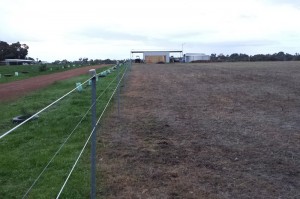Knockdown
 The glyphosate did its job on the capeweed, sorrel and most of the onion weed in the oat paddock. We had sprayed the paddock on the 12th May, as the early break to the season and the heavier than average rain had germinated a lot of weeds. I was wary about using a broad spectrum systemic herbicide, but with the equipment we have for cultivating the paddock, we had little choice. Glyphosate is the most common herbicide used in agriculture (and the urban environment with people splashing Roundup all over the place). The oat paddock is relatively flat and on the top of a hill, so I was not too concerned about run-off to the dam or creek which are over 150m away.
The glyphosate did its job on the capeweed, sorrel and most of the onion weed in the oat paddock. We had sprayed the paddock on the 12th May, as the early break to the season and the heavier than average rain had germinated a lot of weeds. I was wary about using a broad spectrum systemic herbicide, but with the equipment we have for cultivating the paddock, we had little choice. Glyphosate is the most common herbicide used in agriculture (and the urban environment with people splashing Roundup all over the place). The oat paddock is relatively flat and on the top of a hill, so I was not too concerned about run-off to the dam or creek which are over 150m away.
All the literature says that glyphosate is absorbed quickly into the plant and breaks down on contact with the soil, but I have noticed a yellowing of grass where I have walked out of the oat paddock to other places on the property. I didn’t walk through the paddock for at least a week after spraying, so it looks like it stays potent for longer than they make out, or is revived anytime the foliage gets wet with rain or dew.
Having checked the sowing and harvesting dates for the different types of oats, I think we will probably follow this method in the future. By planting in June, we push the harvest out to late October, we can even plant into early July. Last year I had been spooked into planting early with all the neighbouring farmers cultivating and seeding from late April. I had forgotten that they were planting pasture seed rather than oats. We will have to check for a second germination of capeweed over the next 4 weeks and may have to spray again with a selective herbicide, but I hope not.
Apparently Glyphosate
– is one of the least toxic pesticides to animals.
– is an environmentally benign herbicide.
– bonds tightly to soil constituents, with very little movement to soil and groundwater.
– has a relatively short environmental half-life owing to microbial degradation in the soil.
– is not volatile, so there is no atmospheric contamination
– is more environmentally benign than the destructive soil tillage and/or herbicides that it has replaced.
– is less likely to move or persist in ground and surface water than the herbicides it has replaced.

Facebook